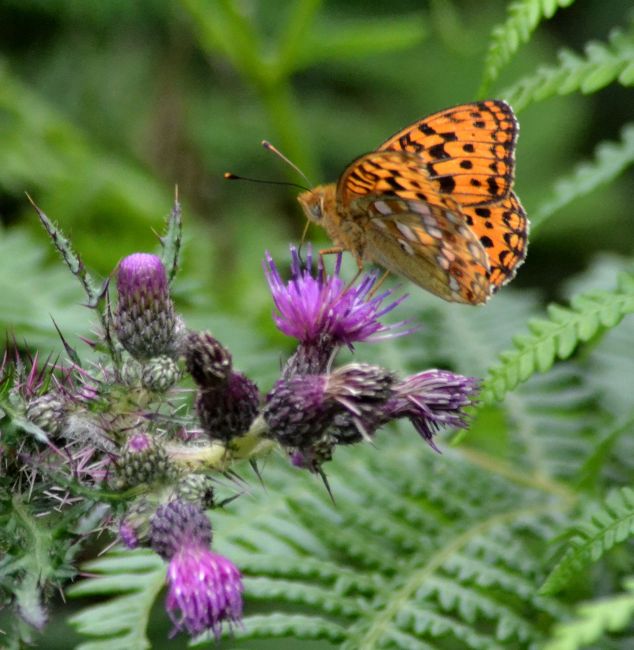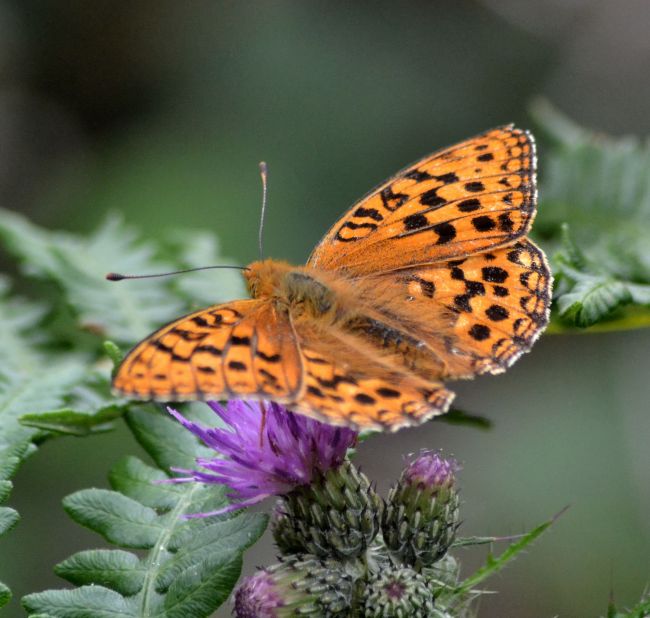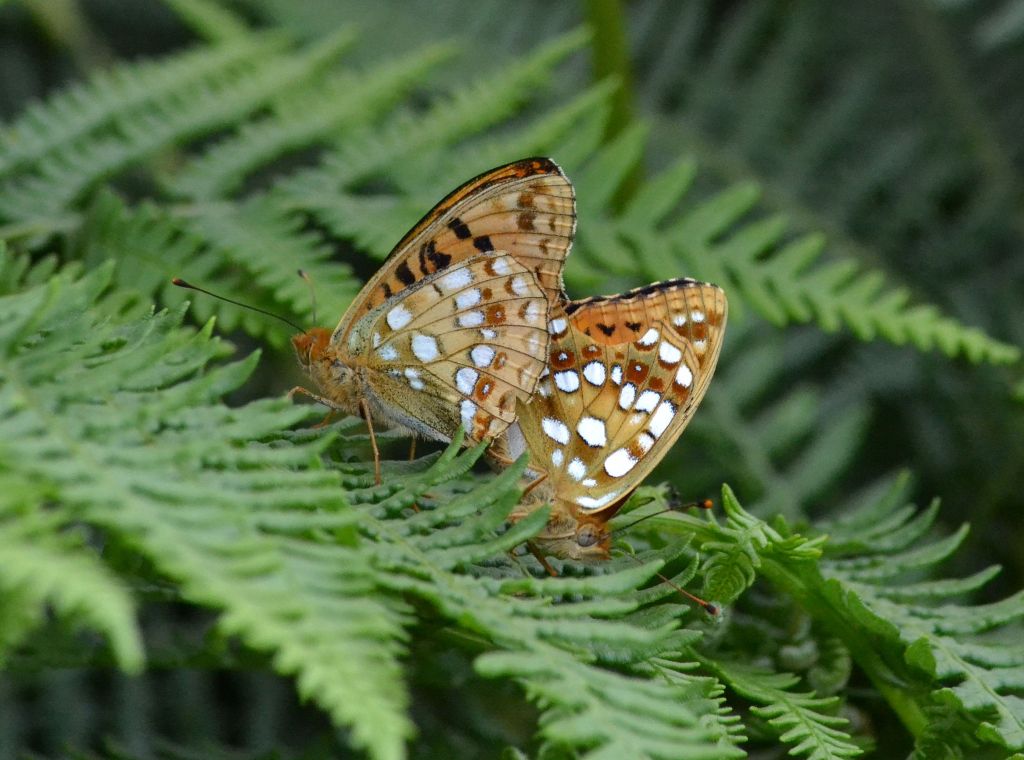The final item on my 2020 wildlife agenda, re-scheduled to 2021 has been to experience one of Great Britain’s most difficult to observe butterflies in possibly it’s least documented location. High Brown Fritillary being greatly reduced in it’s former Cumbria strongholds, extinct in Worcs’ Malvern Hills and viewed poorly by myself only in difficult habitat in Devon – all places in which I had tried for the species previously – I decided to see if things would be any easier with a population near Bridgend in Glamorganshire. The outcome after three attempts may best be described as more of the same hard work though ultimately satisfying.
The Alun Valley Project (see here) involves management by Butterfly Conservation (BC) and partnership organizations of some hillsides and downs above them for HBF. That conservation effort has succeeded in increasing adult butterfly counts many fold since it began in 2002. The longer standing colonies are on Old Castle Down, but since December 2019 BC has attempted to create more habitat on Ogmore Down. That involves opening up dense bracken and scrub with hand tools and mechanical brush-cutters, followed by winter pony or cattle grazing since sheep grazing is unsuitable for producing an even distribution of required habitat.
Like other Fritillaries High Brown is a very picky habitat specialist, requiring unimproved semi-natural grassland in which to breed, and within that habitat pockets of very specialised micro-conditions. Achieving then maintaining all this (bullets) is a very delicate balance:
- A sheltered, usually south-facing, open and sunny slope below 300m altitude
- Bracken stands where the ground is littered with a light covering of dead bracken with sparse grass cover. This needs to be deep enough to provide a warm air pocket, but not so deep that it shades out the food plant
- The sole larval food plant Common Dog Violet amongst that sparse ground vegetation, with relatively high spring ground temperatures when the larvae hatch in March
- A grazing regime that breaks up the bracken by trampling but doesn’t remove the grass or Violets
- A minimum area of 2 to 5 hectares of suitable habitat to support a breeding colony

From a lay-by (CF32 0TA – SS902757) on the B4265 St Brides Road south of Ewenny and just north of Pant Quarry, paths lead west up to Ogmore Down and east onto Old Castle Down that both have open public access. I first visited here a year ago, without realising that Covid travel restrictions had not been eased in Wales as in England. Overhead gantry messages along the M4 proclaimed STAY LOCAL PROTECT THE NHS but didn’t say “If you have come from England turn around and go back”, so how was I to know? Vehicle traffic volumes suggested little attention was being paid to the restrictions which were not being enforced.
That day I first explored Ogmore Down above the working Pant Quarry, encountering Dark Green and Small Pearl-bordered Fritillaries but no HBF. Then I met a friendly local who as well as making me realise I shouldn’t really be there explained the last-named’s established colonies are on Old Castle Down. In the afternoon I crossed the road to that second area but still without success, and so resolved to come back a year later.
I have found published information on HBF in both Devon and Glamorgan to be very scant. Neither county has a BC sightings page and I don’t do social media so the first question is when to visit if a wasted journey is to be avoided. Adults normally fly in June, through the second half of which this journal’s other reference on the Devon sites (see here) became the most consulted post herein, suggesting the HBF season was indeed underway. Then a picture of the butterfly from today’s site featured in BirdGuides’ most recent weekly photo awards, so I awaited a next suitable weather window.
On 5th the BBC Breakfast weather forecast suggested it was indeed worth risking the 127 mile journey in what looked set to be another rainy week. Arriving just after 10:30am the dark grey stuff was stacked up against higher ground to the north of the Vale of Glamorgan, but the site of my intent was still sunlit. That situation lasted for around an hour, during which I surveyed Old Castle Down more or less randomly coming across some Dark Green Fritillaries amongst the more plentiful flying Meadow Brown, Ringlet, Small Heath and Large Skipper.
Then I crossed paths with another local who knew the area and had seen HBF earlier, showing me a picture on the back of his camera. He directed me to what he described as the reliable hotspot, a bracken slope at one end of the public right of way that runs along the southern edge of the open access land between a ford in Cwm Arun and St Brides Major (see map higher up). This was at once recognisable as suitable habitat, with many tall Thistle plants growing amongst the bracken that was noticeably less dense than at the Devon sites of my previous experience. Indeed it was possible to walk in at various points without damaging habitat, to investigate the butterflies that were active here and there.
Midday had now passed and conditions had become largely overcast with the sun attempting to break through on and off. But large Fritillaries were showing at intervals and I resolved just to keep walking up and down the tracks on either side of the favoured patch and persevere. Before too long gaining the poor quality underside study (above) of a High Brown Fritillary meant that mission had indeed been accomplished.
I was now reminded of visiting Aish Tor in Devon in similar weather conditions in 2018. Calling the colleague who had briefed me on that site his advice then was the butterflies would still need to nectar in the early afternoon to fuel up for the rest of their day. That was indeed what transpired here as perhaps three or four individuals, some of them worn all became active, moving around quickly and restlessly while rarely settling or showing their undersides for long. But I was able to obtain other unsatisfactory pictorial records (below) that confirmed the IDs.


This was presumably one of the managed Alun Valley Project colonies, of which there are more. By 14:30 conditions had become cooler and darker grey and the Fritillaries were no longer so visible. I was a long way from my start point of the morning and walking back around the site periphery immediately above the Alun Valley I appreciated having made what was a quite thorough exploration of Old Castle Down for future reference.
Hence my 2020/21 national wildlife agenda had been converted 100% successfully, and I had visited all the British High Brown Fritillary sites of recent history, viewing them poorly at just three. It now remained to re-visit Old Castle Down in the next suitable weather window to seek satisfactory pictures and maybe further colonies both there and on neighbouring Ogmore Down. So three days later (8th) I returned, being concerned to arrive earlier to catch the butterflies as they warmed up with the day.


That plan was scuppered by the mishap of realising after setting out for the hotspot I had left my phone on view in the car, so not wanting to invite a rock through the window I went back and the first hour was lost. Eventually getting down to the task in hand at past 10:30 the HBF were by then quite flighty and showing no inclination to settle on the Thistles to nectar. In bright sunshine they would instead keep landing in the shade of deep cover, eventually to re-emerge far less frequently. More poor quality records were gained including those above that show the top-side male diagnostics clearly enough.
Through the ensuing hour I felt sure the Fritillaries I was watching were High Browns but could not gain the underwing pictures that would remove all doubt. But as three days earlier I reasoned the butterflies would have to fuel up again in the early afternoon, and especially since they were expending a lot of energy. So I next wandered off to check out some other parts of Old Castle Down noted previously, in which differences in the bracken habitat to the managed hotspot were all too apparent.
Retracing my steps after 13:00 the HBFs were flying again but still not settling on the Thistles. Then I noticed a little ground level commotion to one side of the track where an interloper was attempting to muscle in on a mating pair. The next intruder on the scene, myself caused the female to be transported anew to the short grass sward of the track itself where they carried on. Cue a close encounter of the macro kind with which the happy couple were unconcerned.
Observing one of the scarcest British butterflies this well must be an infrequent opportunity, and to get so close to a mating pair in such pristine condition might be a rarer one still. But three times? Yes I encountered what must have been the same pair twice more through the early afternoon. Just look at all those lovely red occoli and the other red bit in the images that kind of stands out! It possibly goes without saying that acceptable pictures for this post had now been attained.
On eventually walking away I met BC’s conservation officer for Wales, Andrea Rowe and a colleague and so took the opportunity to learn more about this site and its HBF project. They confirmed the other managed areas above the Alun Valley are not on publicly accessible land, and that High Browns may also be viewed on the slopes up to Ogmore Down above the B4265 St Brides Road where a deal of volunteer work has taken place. But checking those out would have to wait for another day. It had been a hot and tiring five hours in the field and my legs were aching, so it was time to move on and head home.





